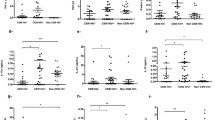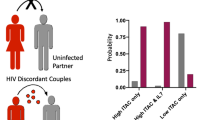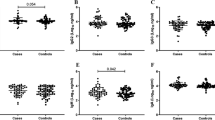Abstract
Introduction
Understanding the genital mucosal immunity and the factors involved in linking innate to adaptive immunity is crucial for the design of efficient preventive strategies against human immunodeficiency virus (HIV)-1.
Methods
Levels of both genital mucosal and blood chemokines were compared between 58 HIV-1-uninfected and 50 HIV-1-infected female commercial sex workers (CSWs) as well as 53 HIV-1-uninfected non-CSW control women at low risk for exposure, recruited in Cotonou, Benin.
Results
HIV-1-infected CSWs had significantly higher blood and genital levels of monocyte chemotactic protein (MCP-3/CCL7) and monokine induced by gamma interferon (MIG/CXCL9) compared with those in both the HIV-1-uninfected CSW and non-CSW groups. In the HIV-1-infected group, levels of MCP-3 and MIG were significantly higher in the genital mucosa than in the blood. However, the blood levels of macrophage inflammatory protein (MIP-1a/CCL3) and MIP-1b/CCL4 were higher in HIV-1-uninfected CSWs compared with those in the other groups.
Conclusion
Increased production of chemokines in the genital tract may favour the recruitment of HIV-1 target cells causing a mucosal environment that promotes viral replication and dissemination, whereas higher expression of β-chemokines at the systemic level is associated with protection from HIV-1 infection.



Similar content being viewed by others
References
Haynes BF, Shattock RJ. Critical issues in mucosal immunity for HIV-1 vaccine development. J Allergy Clin Immunol. 2008;122:3–9.
Padian NS, van der Straten A, Ramjee G, Chipato T, de Bruyn G, Blanchard K, et al. Diaphragm and lubricant gel for prevention of HIV acquisition in Southern African women: a randomised controlled trial. Lancet. 2007;370:251–61.
Hel Z, McGhee JR, Mestecky J. HIV infection: first battle decides the war. Trends Immunol. 2006;27:274–81.
Glass WG, Rosenberg HF, Murphy PM. Chemokine regulation of inflammation during acute viral infection. Curr Opin Allergy Clin Immunol. 2003;3:467–73.
Colobran R, Adreani P, Ashhab Y, Llano A, Esté JA, Dominguez O, et al. Multiple products derived from two CCL4 loci: high incidence of a new polymorphism in HIV positive patients. J Immunol. 2005;174:5655–64.
Gonzalez E, Kulkarni H, Bolivar H, Mangano A, Sanchez R, Catano G, et al. The influence of CCL3L1 gene-containing segmental duplications on HIV-1/AIDS susceptibility. Science. 2005;307:1434–40.
Iqbal SM, Ball TB, Kimani J, Thottingal P, Embree JE, Fowke KR, et al. Elevated T cell counts and RANTES expression in the genital mucosa of HIV-1-resistant Kenyan commercial sex workers. J Infect Dis. 2005;192:728–38.
Hirbod T, Nilsson J, Andersson S, Uberti-Foppa C, Ferrari D, Maghi M, et al. Upregulation of interferon-α and RANTES in the cervix of HIV-1 seronegative women with high-risk behavior. J Acquir Immune Defic Syndr. 2006;43:137–43.
Kaul R, Rebbapragada A, Hirbod T, Wachihi C, Ball TB, Plummer FA, et al. Genital levels of soluble immune factors with anti-HIV activity may correlate with increased HIV susceptibility. AIDS. 2008;22:2049–51.
Campbell GR, Spector SA. CCL2 increases X4-tropic HIV-1 entry into resting CD4+ T Cells. J Biol Chem. 2008;283:30745–53.
Brainard DM, Tager AM, Misdraji J, Frahm N, Lichterfeld M, Draeneret R, et al. Decreased CXCR3+ CD8 T cells in advanced human immunodeficiency virus infection suggest that a homing defect contributes to cytotoxic T-lymphocyte dysfunction. J Virol. 2007;81:8439–50.
Lajoie J, Poudrier J, Massinga-Loembe M, Guédou F, Agossa-Gbenafa C, Labbé AC, et al. Differences in immunoregulatory cytokine expression patterns in the systemic and genital tract compartments of HIV-1 infected commercial sex workers in Benin. Mucosal Immunol. 2008;1:309–16.
Gumbi PP, Nkwanyana NN, Bere A, Burgers WA, Gray CM, Williamson AC, et al. Impact of inflammation on cervical human immunodeficiency virus (HIV-1)-specific DC8 T-cell responses in the female genital tract during chronic HIV infection. J Virol. 2008;82:8529–36.
Wira CR, Fahey JV, Sentman CL, Pioli PA, Shen L. Innate and adaptive immunity in female genital tract: cellular responses and interactions. Immunol Rev. 2005;206:306–35.
Sugaya M, Loré K, Koup RA, Douek DC, Blauvelt A. HIV-infected Langerhans cells preferentially transmit virus to proliferating autologous CD4+ memory t cells located within Langerhans Cell-T cell clusters. J Immunol. 2004;172:2219–24.
Sharkey DJ, Macpherson AM, Tremellen KP, Robertson SA. Seminal plasma differentially regulates inflammatory cytokine gene expression in human cervical and vaginal epithelial cells. Mol Hum Reprod. 2007;13:491–501.
Cohen CR, Plummer FA, Mugo N, Maclean L, Shen C, Bukosi EA, et al. Increased interleukin-10 in the endocervical secretions of women with non-ulcerative sexually transmitted diseases: a mechanism for enhanced HIV-1 transmission? AIDS. 1999;13:327–32.
Boulton IC, Gray-Owen SD. Neisserial binding to CEACAM-1 arrests the activation and proliferation of CD4+ T lymphocytes. Nat Immunol. 2002;3:229–36.
Fichorova RN, Desai PJ, Gibson FC, Genco CA. Distinct proinflammatory host responses to Neisseria Gonorrhoeae infection in immortalized human cervical and vaginal epithelial cells. Infect Immun. 2001;69:5840–8.
Freeman EE, Weiss HA, Glynn JR, Cross PL, Whitworth JA, Hayes RJ. Herpes simplex virus 2 infection increases HIV acquisition in men and women: systematic review and meta-analysis of longitudinal studies. AIDS. 2006;20:73–83.
Rebbapragada A, Wachihi C, Pettengell C, Sunderji S, Huibner S, Jaoko W, et al. Negative mucosal synergy between herpes simplex type 2 and HIV in the female genital tract. AIDS. 2007;21:589–98.
Kaul R, Plummer FA, Kimani J, Dong T, Kiama P, Rostron T, et al. HIV-1-specific mucosal CD8+ lymphocyte responses in the cervix of HIV-1-resistant prostitutes in Nairobi. J Immunol. 2000;164:1602–11.
Kaul R, Trabattoni D, Bwayo JJ, Arienti D, Zagliani A, Mwanji FM, et al. HIV-1-specific mucosal IgA in a cohort of HIV-1-resistant Kenyan sex workers. AIDS. 1999;13:23–9.
Devito C, Hinkula J, Kaul R, Kimani J, Kiama P, Lopalco L, et al. Cross-clade HIV-1-specific neutralizing IgA in mucosal and systemic compartments of HIV-1-exposed, persistently seronegative subjects. J Acquir Immune Defic Syndr. 2002;30:413–20.
Suresh P, Wanchu A, Bhatnagar A, Sachdeva RK, Sharma M. Spontaneous and antigen-induced chemokine production in exposed but uninfected partners of HIV type 1-infected individuals in North India. AIDS Res Hum Retroviruses. 2007;23:261–8.
Schall TJ, Bacon K, Camp RD, Kaspari JW, Goeddel DV. Human macrophage inflammatory protein alpha (MIP-1 alpha) and MIP-1 beta chemokines attract distinct populations of lymphocytes. J Exp Med. 1993;177:1821–6.
Lillard JW, Singh UP, Boyaka PN, Singh S, Taub DD, McGhee JR. MIP-1 alpha and MIP-1 beta differentially mediate mucosal and systemic adaptive immunity. Blood. 2003;101:807–14.
Acknowledgments
This work was supported by grant HOP-79213 from the Canadian Institutes of Health Research (CIHR) and by the Réseau SIDA from the Fonds de la Recherche en Santé du Québec (FRSQ). Julie Lajoie and Marguerite Massinga Loembe hold Student Research awards from the CIHR. Marguerite Massinga Loembe additionally held a fellowship from the AUF (Agence Universitaire de la Francophonie). Michel Alary and Michel Roger are recipients of Research Scholar awards from the FRSQ. We are indebted to Nassirou Geraldo, Aina Gabin, Carmelle Assogba and Clémence Agossa-Gbenafa for their clinical expertise, to Gérard Ahotin, Laurette Djossou and Ella Goma for their technical assistance and to Georges Batona and other field workers who helped with recruitment of CSWs.
Authors' contribution
M. Roger is the lead investigator of this study and with J. Lajoie and J. Poudrier, designed the experiments, performed the analysis and wrote the manuscript. J. Lajoie performed the experiments. M. Massinga Loembe, A-C Labbé, F. Guédou and M. Alary were responsible for the participants' recruitment and provided clinical and laboratory data. M. Massinga Loembe and F Leblond were responsible for the sample processing and data collection. All authors edited and approved the final version of the manuscript.
Conflicts of interest
The authors declare no conflict of interest.
Author information
Authors and Affiliations
Corresponding author
Rights and permissions
About this article
Cite this article
Lajoie, J., Poudrier, J., Massinga Loembe, M. et al. Chemokine Expression Patterns in the Systemic and Genital Tract Compartments are Associated with HIV-1 Infection in Women from Benin. J Clin Immunol 30, 90–98 (2010). https://doi.org/10.1007/s10875-009-9343-3
Received:
Accepted:
Published:
Issue Date:
DOI: https://doi.org/10.1007/s10875-009-9343-3




